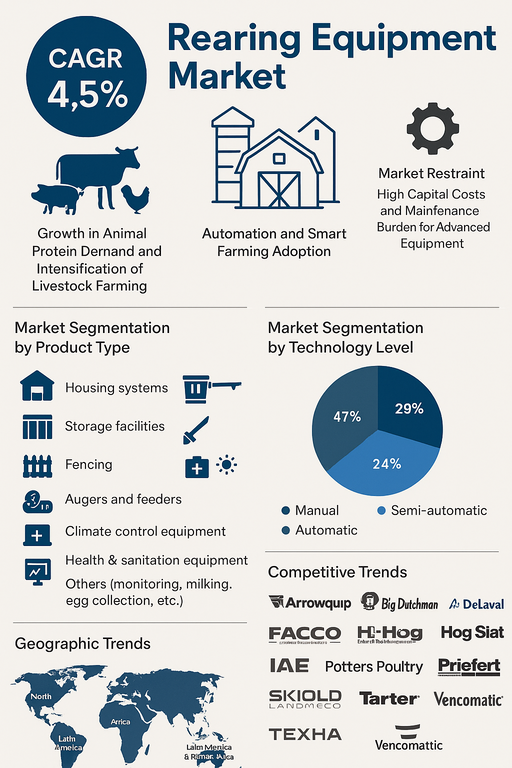The global rearing equipment market is projected to grow at a CAGR of 4.5% from 2025 to 2033, driven by increasing demand for efficient livestock and poultry management, rising global meat and dairy consumption, and automation trends in farm operations. Modern rearing equipment supports productivity, animal health, and operational cost-efficiency across small and large-scale farms, particularly in poultry, cattle, and swine production. The market is also witnessing technological integration for improved monitoring, feeding, and climate control.

Market Drivers
Growth in Animal Protein Demand and Intensification of Livestock Farming
Global consumption of meat, dairy, and eggs is increasing, particularly in developing regions, prompting investments in intensive and semi-intensive farming systems. This has led to higher demand for advanced rearing equipment that ensures animal welfare, biosecurity, and production efficiency in confined operations.
Automation and Smart Farming Adoption
Technological advances in automatic feeding systems, climate control, egg collection, and health monitoring are reshaping animal husbandry practices. Automation reduces labor dependency and enhances operational precision, particularly in large-scale farms, leading to consistent quality and yield improvements.
Focus on Biosecurity, Sanitation, and Animal Welfare Compliance
Rising outbreaks of livestock diseases and stringent regulatory standards have increased the importance of health & sanitation equipment, fencing, and housing systems designed to ensure animal containment, waste management, and disease control.
Market Restraint
High Capital Costs and Maintenance Burden for Advanced Equipment
Fully automated and smart equipment involves significant initial investments and ongoing maintenance, especially in developing economies where smallholders dominate the farming landscape. Cost-sensitivity and lack of technical training limit penetration in low-income and resource-constrained regions.
Market Segmentation by Product Type
The market is segmented into Housing Systems, Storage Facilities, Fencing, Augers and Feeders, Climate Control Equipment, Health & Sanitation Equipment, and Others (including monitoring, milking, and egg collection tools). In 2024, augers and feeders held the largest share due to their critical role in optimizing feed conversion and minimizing waste. Climate control and health equipment are expected to grow steadily, supported by increasing temperature fluctuations and biosecurity focus in high-density farms.
Market Segmentation by Technology Level
Based on technology level, the market is segmented into Manual, Semi-Automatic, and Automatic. Manual systems dominated in 2024, especially among small-scale farmers in Asia and Africa. However, automatic equipment is projected to register the highest CAGR through 2033, driven by demand for labor-saving solutions and integration with farm management software in North America, Europe, and developed parts of Asia.
Geographic Trends
In 2024, Asia Pacific accounted for the largest share of the rearing equipment market due to its vast livestock population, rising protein consumption, and evolving farming practices in China, India, and Southeast Asia. North America and Europe followed, with widespread use of precision farming, biosecurity protocols, and smart equipment. Latin America, led by Brazil and Argentina, is a fast-growing region for poultry and cattle farming investments. The Middle East & Africa is an emerging market supported by government-backed livestock programs and modernization of smallholder systems in countries like Saudi Arabia, UAE, and South Africa.
Competitive Trends
The 2024 competitive landscape was characterized by the presence of global and regional players offering a wide range of livestock and poultry rearing equipment. Arrowquip, Hi-Hog, Priefert, and Tarter Farm and Ranch Equipment provided robust fencing, handling, and housing systems, particularly for cattle operations. Big Dutchman, TEXHA, Vencomatic, and FACCO Poultry Equipment led in poultry farming automation with offerings in egg collection, climate control, and feed lines. CTB, DeLaval, and SKIOLD Landmeco focused on scalable and intelligent systems for swine and dairy farms, including milking systems and waste handling. Potters Poultry, IAE, TecniPlast, and Hog Slat offered customized, modular rearing solutions for regional needs. Ongoing product development includes integration of IoT-based monitoring, automated data logging, and AI-powered feeding optimization to support precision livestock farming.
Historical & Forecast Period
This study report represents analysis of each segment from 2023 to 2033 considering 2024 as the base year. Compounded Annual Growth Rate (CAGR) for each of the respective segments estimated for the forecast period of 2025 to 2033.
The current report comprises of quantitative market estimations for each micro market for every geographical region and qualitative market analysis such as micro and macro environment analysis, market trends, competitive intelligence, segment analysis, porters five force model, top winning strategies, top investment markets, emerging trends and technological analysis, case studies, strategic conclusions and recommendations and other key market insights.
Research Methodology
The complete research study was conducted in three phases, namely: secondary research, primary research, and expert panel review. key data point that enables the estimation of Rearing Equipment market are as follows:
Market forecast was performed through proprietary software that analyzes various qualitative and quantitative factors. Growth rate and CAGR were estimated through intensive secondary and primary research. Data triangulation across various data points provides accuracy across various analyzed market segments in the report. Application of both top down and bottom-up approach for validation of market estimation assures logical, methodical and mathematical consistency of the quantitative data.
| ATTRIBUTE | DETAILS |
|---|---|
| Research Period | 2023-2033 |
| Base Year | 2024 |
| Forecast Period | 2025-2033 |
| Historical Year | 2023 |
| Unit | USD Million |
| Segmentation | |
Product Type
| |
Technology Level
| |
Animal Type
| |
End Use
| |
Distribution Channel
| |
|
Region Segment (2023-2033; US$ Million)
|
Key questions answered in this report